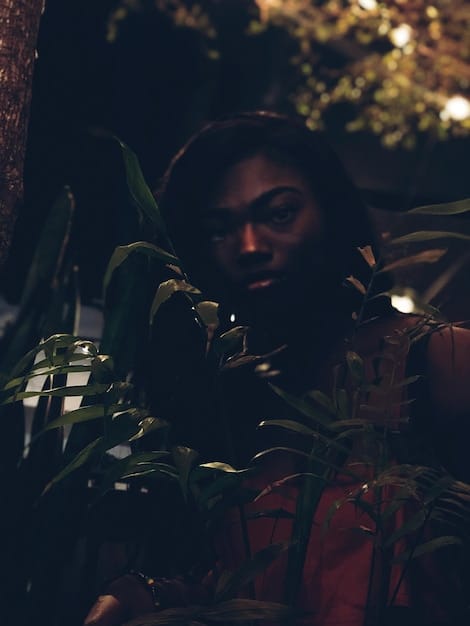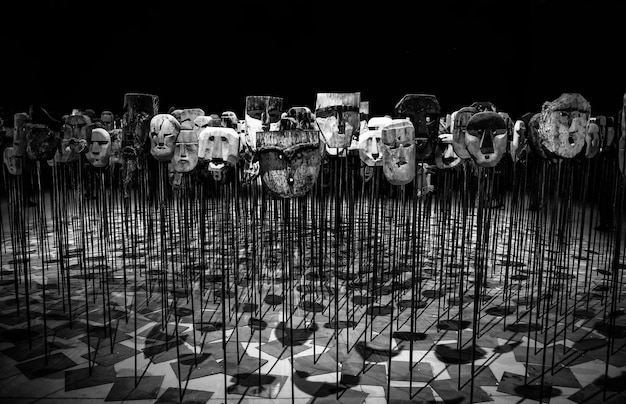Brazilian Horror Cinema: New Wave to Terrify Audiences in 2025?

Is a new wave of Brazilian horror cinema poised to terrify audiences in 2025? Emerging trends suggest a burgeoning genre scene, driven by innovative filmmakers, diverse narratives, and a growing international presence, promising a terrifying resurgence for Brazilian horror in the coming years.
The landscape of global cinema is constantly evolving, with new voices and visions emerging from unexpected corners. In this dynamic environment, a compelling question arises: Brazilian Horror Cinema: Is a New Wave of Genre Films Set to Terrify Audiences in 2025? This inquiry delves into the whispers and roars from the Brazilian film industry, exploring whether a significant resurgence in horror filmmaking is on the horizon, promising to captivate and unsettle viewers worldwide.
The Roots of Brazilian Horror: A Terrifying Legacy
Brazilian horror cinema holds a rich and often unsettling history, deeply intertwined with the nation’s diverse cultural fabric, social anxieties, and unique folklore. From early pioneers to contemporary masters, the genre has offered a distinct perspective on fear, often reflecting the turbulent realities and mythologies of Brazil itself.
Understanding the potential for a new wave requires a look back at the foundations. Early Brazilian horror, while perhaps not as prolific as in other cinematic traditions, laid crucial groundwork, often characterized by experimental approaches and a willingness to confront uncomfortable truths. José Mojica Marins, famously known as Coffin Joe, stands as an undeniable icon, his disturbing and philosophical films forging a path for the genre in Brazil.
Pioneers and Influences
Mojica Marins’ influence is paramount. His Coffin Joe character, a grave digger with a nihilistic worldview, pushed boundaries and challenged taboos in a conservative society. His works, like “At Midnight I’ll Take Your Soul” (1964) and “This Night I’ll Possess Your Corpse” (1967), were not merely shock vehicles; they were daring explorations of morality, religion, and the human psyche, often imbued with a raw, visceral quality that sets them apart.
- José Mojica Marins (Coffin Joe): His unique style and transgressive themes revolutionized Brazilian horror, leaving an indelible mark on subsequent generations.
- Social Commentary: Many early horror films subtly or overtly addressed sociopolitical issues, reflecting the country’s turbulent history and challenging the status quo.
- Folklore and Mythology: Elements of indigenous myths and African-Brazilian folklore often found their way into these narratives, providing a distinct cultural flavor to the scares.
Beyond Marins, directors like Ivan Cardoso explored more comedic and campy takes on horror, creating a subgenre known as “terrir” (terror + risada). This diversity showcased the genre’s adaptability and willingness to experiment with different tones and narrative styles, suggesting a fertile ground for future development. The genre’s historical trajectory, marked by periods of dormancy and sporadic bursts of creativity, provides a context for the current discussions about a new wave, indicating that Brazilian horror has always possessed an inherent resilience and capacity for reinvention.
The legacy of these early filmmakers is not just about the films they made, but the courage they demonstrated in pushing artistic and social boundaries. This spirit of fearless storytelling is a valuable inheritance for any emerging wave, signifying a deep-seated desire within Brazilian cinema to explore the darker facets of existence and society. The enduring impact of these foundational works provides a solid reference point for analyzing how contemporary filmmakers are building upon or diverging from these established traditions, shaping what a new wave might look like.
Drivers of Change: What’s Fueling the Potential Wave?
Several converging factors are contributing to the mounting anticipation around a new wave of Brazilian horror cinema. These drivers range from technological advancements and educational opportunities to evolving audience tastes and a more globalized industry, all collectively fostering an environment ripe for genre innovation and wider recognition.
One significant element is the democratization of filmmaking tools. The increasing accessibility of high-quality cameras and editing software has lowered the barrier to entry, allowing aspiring filmmakers to produce content with professional polish without needing massive budgets. This has led to an explosion of independent productions, many of which find their home online or in smaller festivals, building grassroots momentum for the genre.
Technological Advancements and Indie Spirit
Digital cinema, in particular, has been a game-changer. It has empowered a new generation of directors to experiment with visual styles and narrative structures, often circumventing traditional production hurdles. This indie spirit encourages risk-taking and fresh perspectives, which are vital for invigorating any film genre. The ability to shoot, edit, and even distribute films more independently means that unique and unconventional horror stories can bypass traditional gatekeepers, reaching audiences directly.
- Affordable Equipment: High-definition cameras and post-production software are more accessible than ever, enabling quality productions on limited budgets.
- Independent Productions: A surge in independent horror films, often showcasing raw talent and innovative concepts, is gaining traction.
- Online Distribution Platforms: Streaming services and video-on-demand platforms provide new avenues for Brazilian horror films to reach wider audiences both domestically and internationally.
Beyond technology, a growing number of film schools and workshops across Brazil are nurturing talent specifically interested in genre filmmaking. This formal education provides aspiring horror directors, writers, and technicians with the necessary skills and networks to develop sophisticated and effective horror narratives. Coupled with a burgeoning festival circuit dedicated to fantastic cinema, these educational institutions are creating a pipeline of skilled professionals ready to contribute to a new wave.
Moreover, the global success of horror films from other non-Hollywood regions has opened doors and shifted perceptions. Audiences are increasingly receptive to varied cultural perspectives in horror, moving beyond traditional Western narratives. This global appetite for diverse stories provides a strong incentive for Brazilian filmmakers to lean into their unique cultural heritage—their myths, socio-economic realities, and distinct aesthetic—to craft truly original horror experiences. This confluence of internal capabilities and external demand is steadily paving the way for a vibrant future for Brazilian horror.
Themes and Tropes: Brazilian Horror’s Distinctive Flavor
Brazilian horror cinema, when it thrives, does so by tapping into unique cultural anxieties, rich folklore, and a distinct socio-political landscape. Unlike the often supernatural or slasher-driven narratives prevalent in Western horror, Brazilian films frequently weave in themes that are deeply rooted in the country’s realities, giving them a flavor that is both universally terrifying and uniquely local. This distinctiveness is what could truly define a new wave, setting it apart from global genre trends.
One prevalent theme is the exploration of social inequality and violence. Brazil’s sharp contrasts between wealth and poverty, the favelas, and the ever-present threat of violence in urban and rural settings, offer fertile ground for horror narratives. Films can use the genre to comment on systemic issues, transforming everyday fears into visceral, unsettling experiences. The horror often stems not from mythical creatures, but from the very real dangers lurking in society, making the scares hit closer to home for local audiences and offering a revealing, often shocking, perspective for international viewers.

Cultural Nuances and Folklore
Brazilian folklore, a vibrant tapestry of indigenous, African, and European influences, provides an inexhaustible source of chilling tales. Figures like the Curupira, a forest guardian with backward feet, or the Saci-Pererê, a one-legged prankster, can be reinterpreted to create truly original and terrifying entities. The blending of these traditional myths with contemporary storytelling methods can produce horror that feels both ancient and alarmingly current.
- Urban and Rural Fears: Themes often explore the dangers of dilapidated urban spaces or the isolation and superstitions of rural Brazil.
- Political and Social Commentary: Horror is frequently used as a metaphor for governmental corruption, historical traumas, or the deep-seated social inequalities that plague the nation.
- Unique Mythological Entities: Drawing from a rich trove of folklore traditions (indigenous, African-Brazilian, European), Brazilian horror can generate monsters and threats unseen in other cinematic traditions.
Another powerful element is the use of the uncanny and psychological horror. Brazilian filmmakers often excel at creating an atmosphere of dread that slowly creeps under the skin, rather than relying on jump scares. This approach allows for deeper character exploration and a more profound sense of unease, reflecting a nuanced understanding of fear that goes beyond mere shock value. The claustrophobia of confined spaces, the psychological torment of isolated individuals, or the unsettling nature of distorted realities are all potent tools in the Brazilian horror arsenal.
Furthermore, the exploration of religious syncretism and its darker sides can provide potent thematic material. The blend of Catholicism with African-Brazilian religions like Candomblé and Umbanda creates a spiritual landscape ripe for themes of possession, curses, and spiritual warfare. This provides a unique cultural lens through which to explore supernatural horror, giving it an authenticity and depth that few other countries can replicate. The distinctiveness of these themes and tropes is essential for Brazilian horror to carve out its own niche on the global stage, offering audiences something genuinely fresh and terrifying.
Key Players and Emerging Voices for 2025
The potential new wave of Brazilian horror cinema isn’t just a theoretical concept; it’s being actively shaped by a cadre of talented filmmakers, writers, and producers who are pushing boundaries and finding new ways to tell terrifying stories. Identifying these key players and understanding their creative approaches is crucial to anticipating the direction and impact of this burgeoning movement in 2025 and beyond.
Among the established names, some are continually evolving their craft and mentoring new talent, ensuring continuity and knowledge transfer within the industry. Others are emerging from independent circuits, bringing fresh perspectives and innovative techniques that challenge traditional genre conventions. The dynamic interaction between these generations of filmmakers is vital for a vibrant and sustainable new wave.
Directors to Watch and Production Houses
Directors like Dennison Ramalho, with his gritty and uncompromising approach to horror, have already garnered significant attention with short films and features like “The Trace We Leave” (2017). His work often delves into the darker underbelly of society, combining social commentary with visceral scares. Another director gaining traction is Gabriela Amaral Almeida, whose films, such as “Filho Pródigo” (2015) and “The Animal’s Trail” (2018), often blend psychological terror with elements of folklore, delivering nuanced and unsettling narratives. These filmmakers, alongside others, are developing projects that promise to elevate the genre.
- Dennison Ramalho: Known for his intense, often brutal horror that reflects social decay and urban legends.
- Gabriela Amaral Almeida: Her work typically combines atmospheric dread, psychological depth, and folk elements, delivering sophisticated horror.
- Producers and Production Companies: Independent companies like Produtora Grotesca and others are actively investing in and promoting original horror content.
Beyond individual directors, several independent production houses are playing a pivotal role. These companies are often passionate about horror, willing to take risks on new voices and unconventional scripts. They provide the necessary infrastructure and support for projects that might not otherwise find funding, fostering an environment where creativity can flourish. Their commitment is essential for cultivating a consistent output of quality genre films, forming the backbone of any sustained cinematic movement.
Furthermore, the increased collaboration with international producers and distributors is providing Brazilian horror films with broader reach and financial backing. Co-productions allow for larger budgets, access to diverse talent pools, and better global marketing. This international synergy not only elevates the production quality but also introduces Brazilian horror to new audiences, solidifying its place on the world stage. As 2025 approaches, the synergy between established talent, emerging voices, dedicated production entities, and global partnerships will be instrumental in shaping the next terrifying chapter of Brazilian horror cinema.
International Recognition and Festival Presence
For any national cinema movement to be recognized as a “new wave,” a significant international impact is almost certainly required. For Brazilian horror, this means not only captivating domestic audiences but also making its mark on the global stage through film festivals, streaming platforms, and critical acclaim. The signs are promising, as Brazilian horror films are increasingly finding their way into prestigious festivals and garnering attention from beyond Latin America, signaling a growing appetite for their unique brand of fear.
Film festivals, both genre-specific and general, play a crucial role as launching pads. Events like Fantaspoa in Brazil have long championed independent and international fantastic cinema, including local productions. More importantly, Brazilian horror films are being selected for international showcases such as Fantasia Fest in Montreal, Sitges Film Festival in Spain, and even sections of larger festivals like Cannes or Berlin, which provides invaluable exposure to global distributors, critics, and audiences.

Global Reach and Critical Acclaim
The presence at these festivals often leads to distribution deals. Streaming giants, perpetually hungry for diverse content, have also become key players. Platforms like Netflix and Amazon Prime Video have begun acquiring and licensing Brazilian horror titles, making them accessible to millions of subscribers worldwide. This global distribution is transformative, circumventing traditional theatrical release challenges and allowing films to find their niche audiences internationally. The ease of access, combined with a growing curiosity for non-English language cinema, puts Brazilian horror in a strong position for wider consumption.
- Major Festival Showings: Increased presence at esteemed international genre and mainstream film festivals, boosting visibility and critical buzz.
- Streaming Platform Acquisitions: Major streaming services are licensing Brazilian horror films, expanding their reach to a global audience.
- Positive Critical Reception: Growing body of international reviews praising the originality, themes, and execution of Brazilian horror productions.
Critical acclaim from international reviewers also acts as a powerful catalyst. When films are praised for their storytelling, unique scares, and cultural specificity, it generates buzz and encourages more people to seek them out. This positive feedback loop—from festival selection to critical praise to streaming distribution—is vital for building and sustaining a global reputation. As more Brazilian horror stories resonate with diverse audiences, it reinforces the genre’s universal appeal while highlighting its distinct cultural identity.
Looking towards 2025, a continued and even expanded international presence will be paramount for solidifying a “new wave.” This means active participation in co-production markets, strategic marketing campaigns targeting global audiences, and a consistent output of high-quality films that can compete on the world stage. The goal is not just to be seen, but to be remembered, to carve out a lasting legacy for Brazilian horror as a force to be reckoned with in the international genre landscape.
Challenges and Opportunities for 2025
While the prospects for a new wave of Brazilian horror cinema appear promising, the path forward is not without its challenges. Overcoming these obstacles, however, often unlocks significant opportunities for growth, innovation, and broader impact. Understanding both sides of this coin is essential for an accurate forecast of the genre’s trajectory towards 2025.
One of the primary challenges remains funding. Despite increased interest, securing consistent and sufficient financial resources for film production in Brazil can be difficult. Economic instability and shifting cultural policies can directly impact government grants and private investment, which are crucial for independent filmmakers. This often leads to resourceful solutions, but it can also limit the scale and ambition of projects, pushing filmmakers to constantly innovate within tight budgetary constraints.
Navigating Production and Distribution Hurdles
Another hurdle is distribution, both domestically and internationally. While streaming platforms offer new avenues, securing prime placement and aggressive marketing campaigns can be tough for smaller films. In Brazil, theatrical distribution can be dominated by major Hollywood releases, making it hard for local genre films to find screens and sustain a long run. Overcoming this requires strategic partnerships and creative marketing to capture audience attention.
- Funding Constraints: Limited access to consistent national and international funding sources can hinder production scale and frequency.
- Distribution Bottlenecks: Challenges in securing wide theatrical release and prominent placement on streaming platforms.
- Market Competition: Competing with well-funded international horror productions for audience attention and critical notice.
However, these challenges often breed ingenuity. The necessity of working with limited budgets has fostered a culture of creativity and resourcefulness among Brazilian filmmakers, leading to innovative storytelling and visual effects that rely more on atmosphere and psychological dread than expensive CGI. This “less is more” approach can be a distinguishing characteristic of the new wave, offering a refreshing alternative to effects-heavy blockbusters.
The opportunities, conversely, are immense. The global demand for diverse content is at an all-time high, creating a fertile ground for unique cultural narratives. Brazilian horror, with its distinct themes and folklore, is perfectly positioned to capitalize on this appetite. Furthermore, the growth of international genre film festivals and online communities dedicated to horror provides unparalleled networking and showcase opportunities. Collaborations with international producers and talent can also bring new financial models and production expertise to Brazil, fostering a more robust and interconnected industry. As 2025 approaches, the ability of Brazilian filmmakers to transform challenges into creative solutions and to leverage global interest will determine the true scale and impact of this potential new wave.
The Verdict: Will Brazilian Horror Reign in 2025?
After examining its historical foundations, the changing landscape of film production, the unique cultural flavors, the emerging talents, and the global avenues for recognition, the question remains: is a new wave of Brazilian horror cinema truly set to terrify audiences in 2025? While prognostication is inherently speculative, the evidence points to a strong likelihood of significant growth and impact for the genre, suggesting that a “new wave” is not just a possibility, but an increasingly probable reality.
The stars appear to be aligning. There’s a generation of passionate filmmakers armed with improved tools and a desire to tell authentic, culturally resonant horror stories. They are building upon a legacy of audacious pioneers while simultaneously embracing modern techniques and narratives. The themes they explore—ranging from social injustice to unique folklore—offer a fresh, distinctive voice in a global genre landscape often dominated by predictable tropes.
Outlook and Anticipation
The growing international appetite for diverse, non-Western horror provides a welcoming global stage. Festivals are increasingly receptive, and streaming platforms are actively seeking content that stands out. This provides the necessary visibility and distribution channels for Brazilian horror to break through the traditional barriers that once limited its reach.
- Favorable Conditions: A combination of talent, accessibility to technology, unique narratives, and international interest creates an optimal environment.
- Continued Innovation: Filmmakers are expected to continue experimenting with themes, techniques, and narrative structures, pushing the genre forward.
- Global Impact: Increased visibility and critical acclaim will likely solidify Brazilian horror’s position as a significant player in the international genre scene.
While challenges, particularly around consistent funding and widespread traditional distribution, persist, the ingenuity and resilience of Brazilian filmmakers have consistently shown an ability to overcome such hurdles. The independent spirit, often born out of necessity, is itself a powerful engine for innovation, leading to a focus on compelling storytelling and atmospheric dread rather than reliance on massive budgets.
Therefore, it is reasonable to assert that by 2025, Brazilian horror cinema is highly likely to experience a notable surge. This “new wave” might not be a sudden, monolithic phenomenon, but rather a robust and sustained period of creative output, characterized by distinctive voices, culturally rich narratives, and a growing global footprint. Audiences should prepare themselves for a captivating and uniquely terrifying set of films from Brazil in the coming years, as this burgeoning movement promises to leave an indelible mark on the horror genre worldwide.
| Key Aspect | Brief Description |
|---|---|
| 🎬 Emerging Talents | A new generation of directors gaining international recognition, pushing creative boundaries. |
| 🇧🇷 Cultural Resonance | Unique narratives drawing from Brazilian folklore, social issues, and historical traumas. |
| 🌐 Global Visibility | Increased presence in international festivals and on major streaming platforms. |
| 🛠️ Indie Innovation | Resourceful filmmaking overcoming budget constraints with creative storytelling. |
Frequently Asked Questions About Brazilian Horror Cinema
▼
Brazilian horror often distinguishes itself by blending supernatural elements with deep social commentary, drawing heavily from indigenous and Afro-Brazilian folklore. It frequently explores themes of inequality, political corruption, and urban violence, imbuing its scares with a visceral, often psychological, reality that resonates with the country’s complex societal fabric.
▼
The undeniable pioneer is José Mojica Marins, known as Coffin Joe, whose transgressive 1960s films set the stage. More recently, filmmakers like Dennison Ramalho and Gabriela Amaral Almeida are gaining prominence, known for their ability to craft sophisticated and unsettling narratives that push genre boundaries while remaining culturally authentic.
▼
The anticipation for a new wave stems from several factors: increased accessibility to filmmaking tools, a growing pool of talented new directors, greater international exposure through festivals and streaming platforms, and a global audience keen on diverse, non-Western horror narratives. These elements combine to create a fertile ground for genre innovation.
▼
Brazilian horror frequently draws from a rich tapestry of folklore figures like the Curupira, Saci-Pererê, and various spiritual entities from African-Brazilian religions like Umbanda and Candomblé. This use of local mythology creates unique monsters and curses, offering stories that feel deeply connected to the land and its spiritual traditions, providing fresh scares.
▼
Key challenges include securing consistent funding, navigating complex distribution channels both domestically and internationally, and competing with the massive marketing budgets of Hollywood productions. However, these challenges often foster creativity, leading to low-budget, high-impact films that rely more on ingenious storytelling than expensive special effects.
Conclusion
As we’ve explored the landscape of Brazilian horror cinema, from its storied past to the burgeoning possibilities for 2025, it becomes clear that the genre is poised for a significant resurgence. The confluence of innovative filmmakers, culturally rich narratives, increasing technological accessibility, and a receptive global audience paints a compelling picture. While challenges persist, the inherent resilience and creative spirit of Brazilian artists mean these obstacles often become catalysts for unique cinematic expressions. Audiences worldwide should anticipate a truly terrifying and distinctive new wave of horror emerging from Brazil, enriching the genre with fresh perspectives and unforgettable scares in the coming years.





